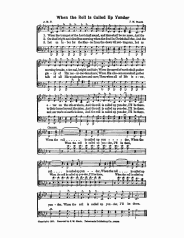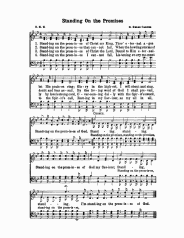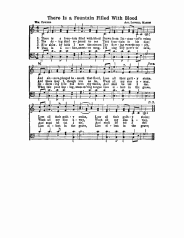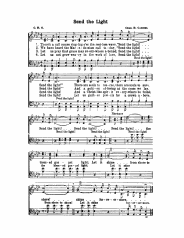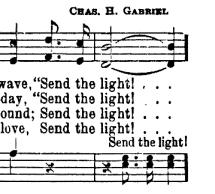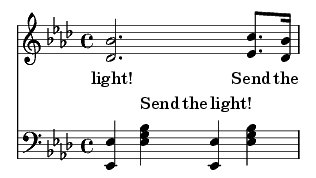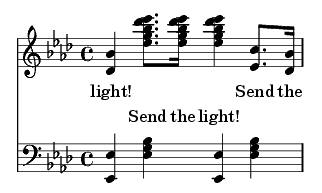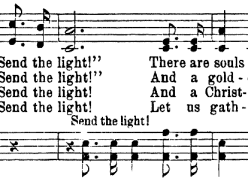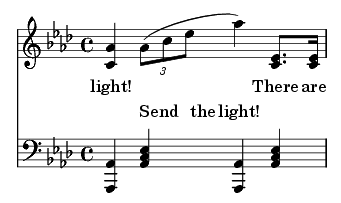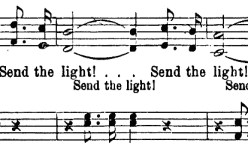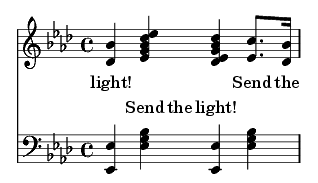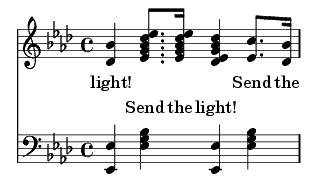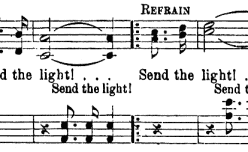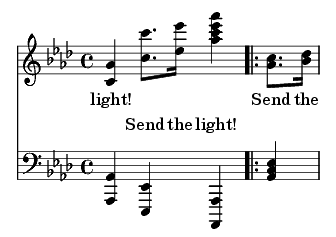What Notes Do I Play?
The first hurdle of creating new runs is to determine what notes to play. The question is not as difficult as it seems, for there are but a few guidelines to follow:
- If it is in the chord, it works.
- If it is in the scale, it probably works.
- If it is not on the scale, but is moving to a note on the scale or in the chord, it should work.
- If it sounds good, it works.
Based on these fairly open-ended rules, you should quickly realize that anything can become a run or fill, as long as it sounds good. Now I realize that these rules are rather abstract, so let us look at some concrete examples of them in action.
If It Is In The Scale, It Probably Works.
When creating a run, it is essential that you have a good grasp of scales. Many classical pianists are well versed in scales, but do not know how or when to apply them. Many church pianists, even if they know how to apply them, stumble when it comes to scale passages. We should seek a balance between the two: The more you know about how to apply scales, the better you should be at playing them. Having a practical working knowledge of scales is the greatest benefit to improvisation; learn scales well, and nothing will be out of your grasp.
Using scales for runs in the evangelistic style are perhaps one of the most impressive musical elements one can produce. The steps involved are as follows:
- Determine where you are trying to put the run.
- Decide on a target note.
- Choose an appropriate rhythm for the run.
- Count how many notes will fit into the run.
- Adjust the starting note so that it is the first note of a chord.
- Make sure it sounds good!
Look at the song When The Roll Is Called Up Yonder. If you wish, you may print out the sample provided below, or you may reference your own hymn book. We will be looking at short runs first, usually lasting only one beat, which occurs in the melody. These small runs are a great introduction to the larger, sweeping runs you will learn later.
If It Is In The Scale: Example 1
Determine where you are trying to put the run.
For the first run, look at the fourth beat of the second measure. Here, the words “And the” provide a good place for a small run, since the melody line is ascending already.
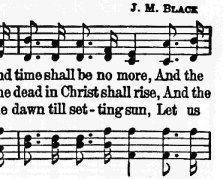
Hymnal Version
Decide on a target note.
The target is the word “morning”, the first beat of the next measure. Therefore, our target note is C.
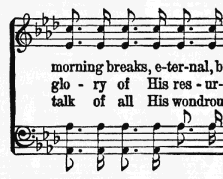
Target Note
Choose an appropriate rhythm for the run.
The rhythm for the fourth beat (“And the”) is a dotted eighth and sixteenth, giving you two notes on the beat. Now, in the evangelistic style of playing, triplet runs are very common. One could even say that triplets define the evangelistic style. With this in mind, you will incorporate triplets into your run.
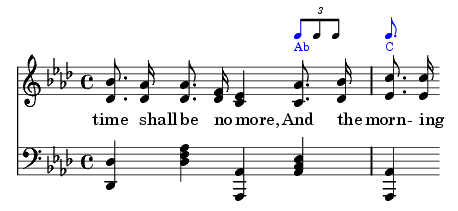
Rhythm Desired
Count how many notes will fit into the run.
Since this is a one beat run of triplets, and we already know what the starting note is, we only need to decide what the middle two notes need to be.
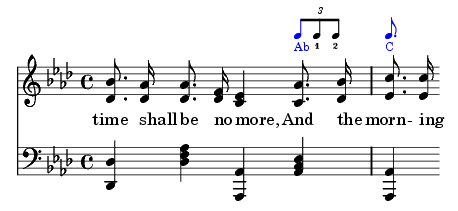
Notes Counted
Adjust the starting note so that it is the first note of a chord.
If you back away from C three scale tones, you will be playing G, Ab, and Bb. This is bad for two reasons. First, G is not part of the Ab chord, which is the underlying chord of the passage. Secondly, the melody note is Ab, so playing a G first will conflict with the melody. You must adjust the run so that Ab is the first of the triplets. This creates a new problem, though, for now you will get to your target note (C) too early. The remedy is to modify the run to include chromatic steps toward the end. In this situation, play Ab, Bb, and B. This will lead you to the C nicely.
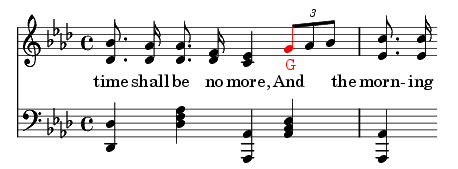
Mis-Matched Starting Note
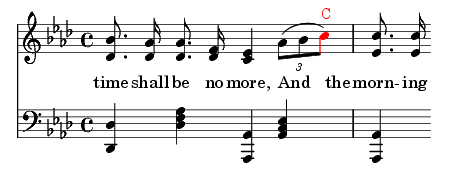
Starting Note Corrected, Target Reached Too Soon
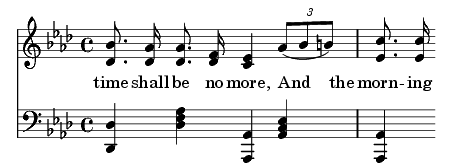
Since you are an observant pianist, you are probably saying, “Wait! B is not in the scale!” This is true, but it is acceptable since it is only played in passing. This will be discussed more in the next section when talking about the third rule.
Make sure it sounds good!
This run sounds best played in octaves, but is not limited to such. Since this is an easier run to implement, you may be tempted to play it too often. Remember: If your ear anticipates hearing this run every time you play through the song, you are probably using it too much.
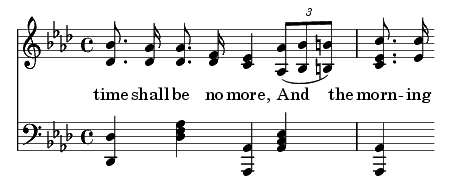
If It Is In The Scale: Example 2
For our second example, we will create a run for a longer passage, using the same principles we used earlier.
Determine where you are trying to put the run.
This run will be placed on the first beat of the fourth measure, at the word “fair”.
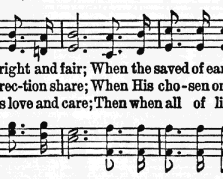
Decide on a target note.
The target note is Ab, the first note of the next phrase, “When the saved of earth…”
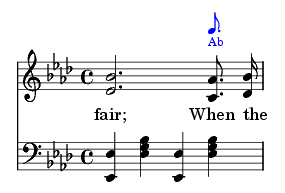
Choose an appropriate rhythm for the run.
Again, since triplets are characteristic of the evangelistic style, they will be our rhythm of choice for this run.
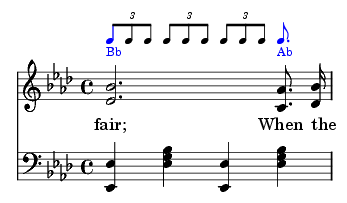
Count how many notes will fit into the run.
The word “fair” is held for three beats, and the number of triplets in three beats is 9 (3 x 3 = 9), but this does not mean that you will use 9 triplets in your run. Since the first triplet of the measure is Bb (the melody note), you will probably have to begin your run on the second eighth note triplet of the first beat.
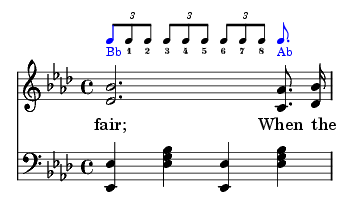
Adjust the starting note so that it is the first note of a chord.
The eight chord tones preceding the target note, Ab, are: G, Ab, Bb, C, Db, Eb, F, and G. Since the underlying chord is Eb, the starting note G will work well for this run.
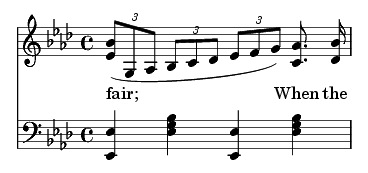
Make sure it sounds good!
Play this run as it would appear in the music. As is common with runs in the evangelistic style, this would sound better if played on octaves. You can also see that this run can easily push the melody an octave higher, making it a good transition from the basic style of hymn playing into the right hand octave style of playing. Remember to keep the O/C steady as you play!
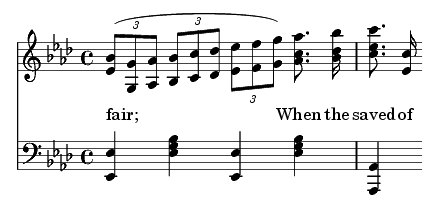
Put two runs together!
This passage offers a good time to put two shorter runs together to form one long, sweeping run. Use the triplet run you just learned for the first three beats of the measure, then append the one beat triplet run you learned in Example 1 to the fourth beat of the measure. The end result is a four beat run that, when executed cleanly and crisply, convey the majesty and joy of the words, “When the roll is called up yonder, I’ll be there!”
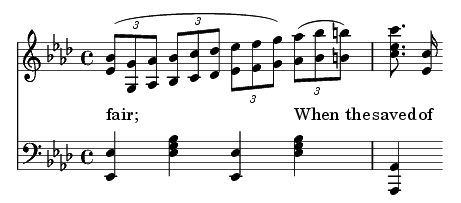
If It Is In The Scale: Example 3
For this third example, you will learn perhaps your most useful run: the one octave triplet run.
Determine where you are trying to put the run.
This run will be placed on the first measure of the chorus, on the word “roll”.
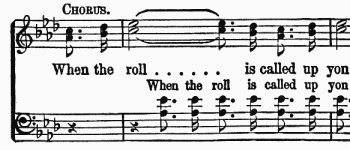
Decide on a target note.
The target note is Eb, on the third beat of the measure. Notice that, in each of the previous runs, the run ended on the next word or note. In this case, however, the run only takes place during the one word, “roll”.
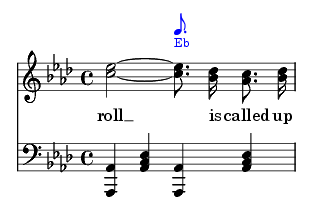
Choose an appropriate rhythm for the run.
Again, the evangelistic style almost demands a triplet run!
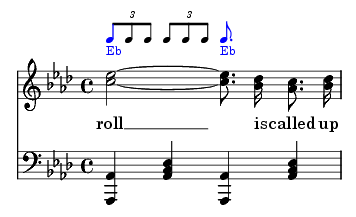
Count how many notes will fit into the run.
You only have two beats to complete this run, since the target note is exactly on the third beat. Therefore you have 5 notes to add (the first note of the measure, Eb, is not considered part of the run).
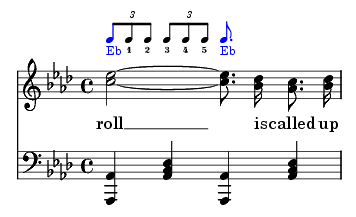
Adjust the starting note so that it is the first note of a chord.
Five scale tones from our target note (Eb) are: G, Ab, Bb, C, and Db. Now the underlying chord for this measure is Ab, which does not blend well with the starting note of the run (G). Therefore, you must move the first note of the run up to Ab. Compensate for this by adding chromatic steps at the end of the end of the run. Now your run should be: Ab, Bb, C, Db, and D. This leads nicely to the Eb of the third beat, an octave higher!
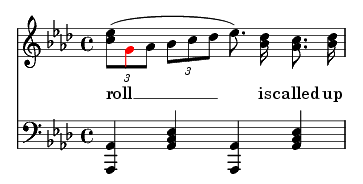
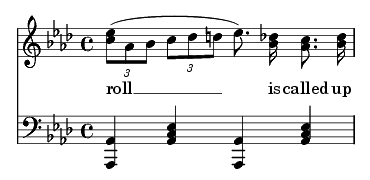
Make sure it sounds good!
As always, the evangelistic style runs sound best in octaves, and work best when playing the right hand in octaves.
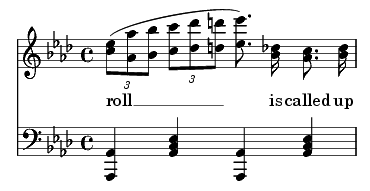
If It Is In The Scale: Example 4
Runs are not limited to the right hand, but can be used quite effectively in the bass line as well. In fact, these types of bass runs dominated the playing of Rudy Atwood, a man whose radio presence on the Old Time Revival Hour helped define the evangelistic style. Often, the left hand is considerably less agile than the right hand, so care must be taken not to make the runs sound sloppy. When given proper attention, bass runs not only add an interesting variation to hymn playing, but allow an interesting interplay between the left and right hands.
Determine where you are trying to put the run.
For this example, you will play a bass run in the second measure of the chorus. It appears on the syllable “yon-” (the word “yonder” in the soprano line) and lasts for two beats, ending on “-der”.
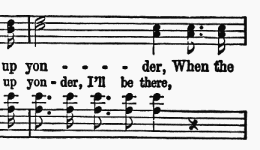
I am confident that you understand the concepts we have been using, so I will not waste space illustrating each step along the way. I will, of course, provide the end result at the conclusion of this example.
Decide on a target note.
The target note is Ab, which appears in the bass line, on the third beat (“-der” in the lyrics).
Choose an appropriate rhythm for the run.
What rhythm? Triplets, of course!
Count how many notes will fit into the run.
Five notes will fit between the beginning Ab and the ending Ab an octave higher. They are: C, Db, Eb, F, and G.
Adjust the starting note so that it is the first note of a chord.
Since the starting note (C) is in the underlying chord (Ab), no change needs to be made to the run.
Make sure it sounds good!
This run sounds best in octaves, but should be played without the sustain pedal! Sustain the notes in your right hand by holding down the keys the appropriate two beats, and work with your left hand so that the notes come out distinctly, cleanly, and quickly! Make sure that you do not lose the beat when playing a run in the left hand. Just as with the O/C, keeping a steady beat is your highest priority!
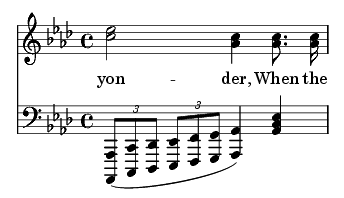
If It Is Not On The Scale, But Is Moving To A Note On The Scale Or In The Chord, It Should Work.
In the previous section, we saw how that scale runs sometimes had to be modified to include half steps. This is an example of the third rule: If it is not on the scale, but is moving to a note on the scale or in the chord, it should work. Unfortunately, this rule is also an “anything goes” catchall, which makes it difficult to describe fully. Hopefully these few examples will serve to introduce the concept.
If It Is Not On The Scale: Example 1
For this example, we will use the hymn Standing On The Promises.
Look at the second measure of the chorus of Standing On The Promises. Suppose you wanted to put a run between this measure and the next. A chromatic run would fit here quite well.
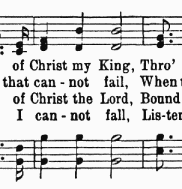
Since the notes are so close together (Bb down to G), all we need is one beat of triplets. Look at the example below.
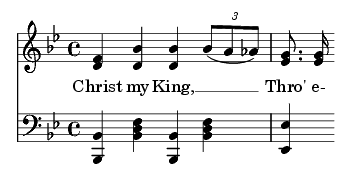
This run works for several reasons: First, the run incorporates every note chromatically between the Bb and the G. Second, the Bb, A, Ab movement suggests a Bb7 chord, which naturally leads into the Eb chord of the target measure. More information on this can be found in the section on Chord Movement Patterns.
If It Is Not On The Scale: Example 2
For this example, we will use the hymn There Is A Fountain.
Look at the song, There Is A Fountain, at the fourth beat of the tenth measure (the word “Lose”). In this situation, a short chromatic run can be played, overlaying the melody. Since this is a slower song (and since the beginning note and target note are so close together), play the run in eighth notes.
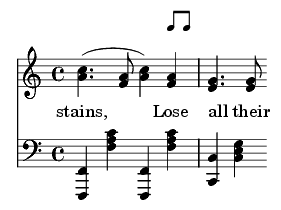
The beginning note is A, taken from the melody. The ending note is G, also taken from the melody, the first beat of the next measure.
Since there is only one eighth note to add, and only one note between the A and G, it should be obvious that the Ab will be the note to fill in.
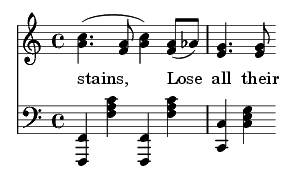
This fill works for two reasons. First, the chromatic note (Ab) is not on an accented part of the beat, so even though it is not in the chord or scale, it is not played long enough to have an adverse effect on the music. Second, the eighth note pattern is consistent with the melody rhythm in the rest of the song.
Some may ask, “But why didn’t you use triplets?” The answer is Step #6, “Make Sure It Sounds Good”. This song is slower, and is normally played with very even eighth notes. While many evangelistic songs are played with a swung feel (which lends itself to the eighth note triplets), this song almost never is. Since, as a pianist, you goal is to enhance the music, you should refrain from using triplets in this song, unless you are using it for a specific reason. There is no clear-cut guideline as to whether or not you should use triplets, but all that is needed is a little bit of familiarity with what is possible, and you will soon be making a good decision.
These examples should help you understand that, in music, anything goes, as long as it sounds good, and does not detract from the message of the song.
If it is in the chord, it works.
This is the simplest rule, yet will meet most of your fill-in needs. To use this rule, however, you must be familiar with all the different types of chords, found in the chord tutorial. Let’s begin by looking at the old missionary standard, Send The Light. If you wish, you may print out the sample provided below, or you may reference your own hymn book.
First Example
Send The Light has many places where different runs and fills can be added. One of the most obvious places to add a fill is during any of the multiple beat notes. Consider the third measure, in which the word “light” is held for three beats. You could just play three beats of the octave and chord, or you can use what you know about chords to add notes in the right hand.
|
Hymnal Version |
|
Plain Octave/Chord Version |
The underlying chord for this measure is the Eb7 chord. (If you are unfamiliar with how to analyze which chord should be played during a particular measure, please read our section on chords.) One thing that most people forget is that the Eb7 chord (as with any chord) is repeated over and over on the keyboard. Therefore, to fill in this “dead space” you can play an Eb7 chord anywhere on the piano. For this example, play a full Eb (or Eb7, if you like) an octave higher as a block chord (playing all the notes simultaneously), using the rhythm which appears in the alto, tenor, and bass lines. Remember to keep the O/C steady in your left hand!
|
Hymnal Version |
|
Fill-In With Rhythm From Tenor And Bass |
Second Example
Now look at the fourth measure, which also holds out the word “light” for three beats, this time on an Ab chord. You could use the same technique as you did in the preceding measure, but you are trying to learn variety, right? This time, will play an Ab chord an octave higher, but instead of playing it as a block chord, arpeggiate it in triplets, as in the example. Just as before, keep your left hand steadily dictating the beat.
|
Hymnal Version |
|
Triplet Arpeggio |
Third Example
Now look at the seventh measure, which is also the word “light” held for three beats. Again you are faced with an Eb7 chord. In this case, play two inversions of the chord moving down the keyboard, as you can see in the example. This is a particularly well fitting addition, for it sets up the continuing downward motion of the following measure. For added effect, you could also mimic the rhythm of the alto, tenor, and bass.
|
Hymnal Version |
|
Chord Descending |
|
Chord Descending (With Rhythm) |
Fourth Example
Finally, look at the eighth measure, which again is the word “light” held for another three beats of the Ab chord. This time, use both hands on chord tones. In the left hand, we will step (in octaves) down from an Ab, to an Eb, and then to a final low Ab. (Note: Since the song does not end at this point, don’t forget to play the Ab chord for the fourth beat of the measure, so that the beginning of the chorus does not seem empty.)
In the right hand, we will play inversions of the Ab chord ascending, as seen in the example. In this option, notice that some of the notes played in octaves in the right hand in octaves have no chord tones. This is because the notes are moving so quickly that the passage sounds muddy or cluttered if you try to play the entire chord every time. This technique is called "outlining the chord". The contrary motion (two hands moving in opposite directions) in this particular fill-in serves to broaden the sound and give a full conclusion to the musical thought. Since it gives a feeling of finality to the phrase, this fill-in is a common ending for verses and choruses alike, when playing in the congregational style.
|
Hymnal Version |
|
Contrary Motion |
I hope that you are seeing how you can use simple chords to fill the holes in music, but I must warn you: The natural tendency is for you to think “Wow, this is great! I’m going to read all the other sections right now!” While I hope you are this enthusiastic, I am afraid that you will then be overwhelmed with all the new information, and while trying to put it all into practice, become bogged down by it instead. Rather, I encourage you to master the information in this section, and then move on to greater things. Please take the time to follow the steps given below, and enjoy the new skills you are developing!
In all, you have just seen four fills to be used in this song. The chorus contains six more fill-in opportunities very similar to the four just discussed. Identify them, and improvise a fill-in based on the four previously studied.
Always perfect each fill-in you use. A well executed fill enhances the song. A sloppily executed fill makes you sound amateurish. In order to master each fill, play the entire song, using only that fill. In other words, when playing Send The Light, play the first pattern at each of the ten fill-in opportunities throughout the song. The second time through, you should play the second pattern at each of the ten fill-in opportunities throughout the song. Repeat this until you have utilized all four patterns. Repeat any patterns that are giving you trouble.
You may notice that when you use the same pattern repeatedly in a song, that your ear begins to anticipate hearing that particular pattern at the next opportunity. This is good when you are practicing, because it helps you to hear and play the fills in the right place, but it is bad in performance, because it means that you are using that particular pattern too often.
Now play through the song using a different fill at each opportunity. The second time through, you should play a different fill from the time before. Make it your goal to never play a song the same way two times in a row, lest you fall into a rut, and your playing grows common and stale. There are 1,048,576 ways to play this song, using only the four fill-ins provided in the ten different opportunities in this song, and there are 78,732 ways to play this song if you never repeat the same fill twice in a row! Obviously, some ways will sound better than others, but I do believe the point is clear: Never play a song the same way twice!
Find other songs of like style (ex. There Is Power In The Blood, Kneel At The Cross, He Keeps Me Singing, Take The Name Of Jesus With You, etc.) and apply these four patterns to their fill-in opportunities.
Experiment. There are many other ways to use chords as fills, but it is up to you to find the ones that best compliment your particular style of playing.
If it sounds good, it works.
This is the ultimate test as to whether or not to play a run at a particular place in the music. Your ear must be critical of your own playing, and constantly asking questions such as:
- Does this run fit the characteristics of the song?
- Am I playing this pattern too often?
- Do I actually need to play a run here, or I doing it just because of habit?
- What else could I play?
- Does this style match the mood of the service?
- Will this fill add or detract from the message of the song?
You should always be thinking about your playing, so that you may better serve in your role as a church pianist. Listen to others when they play (especially good musicians) to see what you can incorporate into your own playing. Most importantly, remember that God must receive the glory in the music service. Play well, and give God all the praise and honor for what He has done through you.
